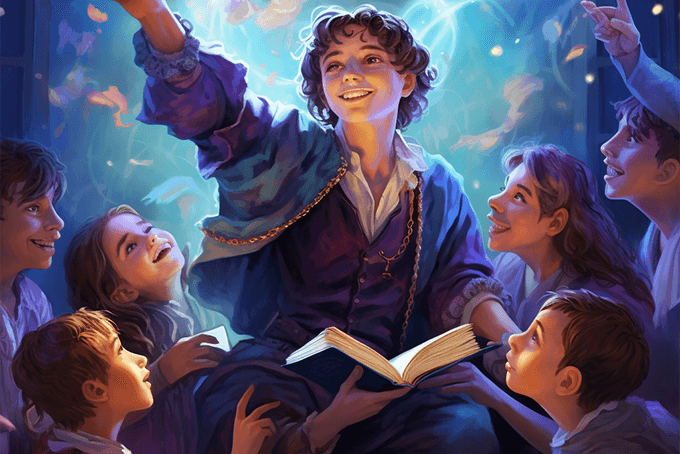In the 2001 BBC short film Black Adder: Back and Forth a time-traveling Rowan Atkinson runs into none other than the famous William Shakespeare. After obtaining an autograph, Atkinson punches Shakespeare (played by Colin Firth) right in the kisser. “That was for every school boy and school girl for the next four hundred years,” he proclaims. “Have you any idea how much suffering you’re going to cause?”
Sad, but true. There seems to be a serious love/hate relationship with the Great Billy Shakespeare. On the one hand, he is acknowledged as a master of the English language. There are entire theater companies and libraries across the world dedicated solely to studying and producing his work. On the other hand, if you bring up the prospect of studying a Shakespeare play in a classroom, you’ll be met with the same reaction:
Ughhhhhhhhh. Please. Not this guy.
He’s boring. He’s indecipherable. Why can’t he just say what he means? Why confuse us by making the language overly complex? If I have to read the phrase “what, ho!” one more time I’m gonna need a swig of Romeo’s arsenic for myself. Why are we still studying this guy?
Judy Asselin, my old English teacher at Westtown Middle School, was happy to provide an answer for me in a recent interview.
“Shakespeare was the first ‘modern’ playwright in that he understood and tried to dramatize the inner workings of the psychology of his characters in a way that no other writer had achieved to that point. His characters seem real to us now because he captured them so fully in all their contradictions and nuanced behaviors. His use of language, of course, is also extraordinary; with a vocabulary that is double what most of us use in our conversation and writing, he had an enormous verbal palette with which to create his characters.”
Then why does the Bard give students such grief? My personal opinion: our method of teaching his plays is all wrong. It is very possible for kids to like Shakespeare. How? Well, not by making his plays into glitzy movies with an inordinate amount of shouting and gunfire (Yes, I’m looking at you, Baz Luhrman). And certainly not by forcing kids to silently read and essentially memorize an entire play by quizzing them on minute, inconsequential details (“What was the name of the Nurse’s daughter in Romeo and Juliet?”). Shakespeare can be made enjoyable by simply remembering two things.
1. Shakespeare’s Works are not the Holy Bible.
There’s this bizarre tendency to treat Shakespeare with an unabashed reverence, as if you need to wear white gloves every time you touch an anthology. My mother would describe her teacher reading passages of his plays to the class, and then looking at the class dramatically, as if waiting for them to closer their eyes and whisper “amen.” As if reading his words was the height a person could achieve in prestige and dignity.
Guys. Have you read any of Shakespeare? I’m not saying he’s not the shiz1. He is. His language transcends to a heightened reality and intense emotional state that is poetic and deeply moving. But…one of his most famous scenes involves the queen of fairies having sex with a donkey. Let’s have a little perspective here.
Shakespeare’s works aren’t exactly sacrosanct.
1. He routinely makes enough jokes about syphilis and genitalia to earn him a spot on the South Park writing staff.
2. In Shakespeare’s time, attending one of his plays was basically the equivalent of going to a strip club. It was for the scum of the earth, uneducated “groundlings” who paid a penny to get in and would often shout crude remarks at the actors on stage (you can see instances of audience interaction written in throughout his work). It was certainly not intended for the respectable noblemen of the day.
That means it’s okay to, y’know, make his work fun! We don’t need a kneeling board and prayer shawl to read about Titus chopping up Tamora’s sons and feeding them to her as dinner. You can play a little fast and loose with this stuff.
Judy Asselin does just that. Working with a method she learned from the Folger Library in a program called “Shakespeare Set Free,” she corrects this foreign, unattainable, and erudite image of Shakespeare for her students as she throws a “Shakespeare Festival.” Every three years students take workshops on the food, clothing, culture, science, combat, and even penmanship of the day. The festival culminates in a feast and production of three different Shakespeare plays (one by each grade).
Ms. Asselin explains.
“Students often think of Shakespeare as an antiquated, distant writer who is inaccessible to ordinary people today, and yet he was essentially the popular TV writer of today, capturing the public’s imagination in profound ways. He was enormously popular in his lifetime. Studying his plays in the contexts of Elizabethan England gives students the chance to fully immerse themselves in the world that he lived in.”
Students of Westtown School studying Romeo and Juliet can sometimes be found outside the middle school building, divided into teams of Capulet and Montague, lobbing Shakespearean insults at each other while teachers award points based on who had the superior wit.
Sounds like a lot more fun than writing translations at a desk, now, doesn’t it?
So let’s not treat studying Shakespeare’s plays as if it were Sunday Mass. Even the Bible doesn’t get as raunchy as Measure for Measure does.
2. Stop Reading Shakespeare – A Scene is Worth a Million Words
Now that we’ve established what Shakespeare’s plays are not, let’s remember what they are. Plays. So…
Stop. Reading. Them. Experience them.
Shakespeare concluded his famous opening sonnet of Romeo and Juliet by asking the audience, “If you with patient ears attend.” The first thing he does in one of his most iconic plays is to merely ask us to listen. With our ears.
Can’t do that reading silently at a desk.
So get up! Yes, get out of your desk! Unlike the great novelists, Shakespeare’s characters don’t live on a piece of paper. They live on the stage. If you want to experience them, especially as a first timer, you have to either see a live production, or act it out yourself. If you’re a teacher faced with the daunting task of teaching a room full of life-hating puberty-ridden hell spawn Macbeth…congratulations! You just found yourself an acting troupe.
Ms. Asselin teaches Shakespeare in just this manner every year.
“Plays are built on character, inner and outer conflict, dramatic situations, staging, gestures, entrances and exits. [Shakespeare] was brilliant at constructing plot, how the story unfolds, and that is all best understood by getting the scenes on their feet. Much of the humor and dramatic irony depends on where actors are standing, what they are doing, who is on stage, who is overhearing whom, etc. All of that becomes crystal clear when you stage the scenes. If a picture is worth a thousand words, a staged scene is worth a million!”
I can vouch for this method, as I myself learned from Ms. Asselin in my days at Westtown Middle School. I experienced Twelfth Night in her classroom, where I wore a special “Cesario” hat and made moon eyes at my classmate who wore his “Duke Orsino” crown. Like my classmates, I skimmed through the confusing language before class and read only the English “translation.” But somehow, as soon as I spoke the words of the original text aloud, I understood what they meant clear as day. It is in these moments that you understand that Shakespeare does say exactly what he means. He just means something infinitely more complex and passionate than ordinary words could possibly express. The lesson stuck with me and to this day Shakespeare is still the author I connect with above all others.
Recently I’ve been asking people around me through social media, casual conversations, and the occasional street assaults about how they were instructed in the Bard’s works and how they feel about him today. There seems to be a startling correlation between current level of esteem towards Shakespeare’s work and the manner of which it was first instructed. People who seemed to enjoy studying Shakespeare all seemed to experience it in the same manner I did: by acting out the scenes and working through the play as a living entity and not something that is dead on the page. The people who found studying Shakespeare to be the equivalent of half a dose of Ambien often just read him in class and then either discussed it the next day or took an overly detailed quiz.
The English Journal published an interview they conducted with a few high school students who had experienced this method of learning Shakespeare through performance. They all had the same experience I did, finally feeling the true impact of Shakespeare’s words only when they heard or said them out loud. “After I acted out a scene from Romeo and Juliet, I understood it more. I actually felt the story,” writes Orubba Almansouri of Brooklyn International High School. Jessica Sawdy adds, “When you read it by yourself silently, you’re examining Shakespeare from the outside trying to look in. When you’re acting it out, though, you’re inside the play, looking out at the world. Then it comes alive.”2
Not only is it helpful for students to act out the scenes themselves, but it helps the other students who are watching to see the scene performed. They are experiencing it as the groundlings did hundreds of years ago. I still laugh as I remember my classmates acting out the “yellow stockings” scene from Twelfth Night. I can see my friend lunging for his “Olivia,” who shrieked and jumped back in surprise. I had no part in the scene, but it still stays with me more profoundly than anything I have ever read at my desk.
Shakespeare isn’t Rocket Science…Really!
A few years ago I dragged my poor Engineer roommate to see a production of Cymbeline with me. She had never seen a Shakespeare production before, and was wary that she wouldn’t be able to understand any of it. Not only did she understand it, she greatly enjoyed it. “But, let’s be honest,” she said as we exited the theater. “It was helpful that half the time they were just speaking straight up English.”
I looked at her sideways. “No, they weren’t,” I said. “That was the original text.”
She looked at me unbelievingly, “But it was so easy to understand!”
Yup. Like so many things, Shakespeare works a lot better in practice than in theory. Even now, many years after my days experiencing Shakespeare with funny hats and foam swords, I still read Shakespeare passages out loud to myself (apologies to my roommate) in order to glean the full meaning.
Look, you don’t have to be super smart to understand Shakespeare. I promise. You just have to open your mind to a new way of thinking about language, and that doesn’t happen by staring at a page and googling all the archaic words you don’t understand. So don’t hate on Shakespeare, okay? It’s not his fault. We’ve just been going about this the wrong way. Let’s let kids experience these transformative worlds Shakespeare created for us, so that they might throw their arms out and declare “I like this place. And willingly could waste my time in it!”3
1 “Shiz” is a slang word for something that’s ‘super cool.’ I just thought if you’re teaching students your language, you should learn theirs, too.
2 Orubba Almansouri, Allam S. Balian and Jessica Sawdy. The English Journal. Vol. 99, No. 1 (Sep., 2009), pp. 35-36
3 That’s from “As You Like It,” in case you’re less of a nerd than I am.



